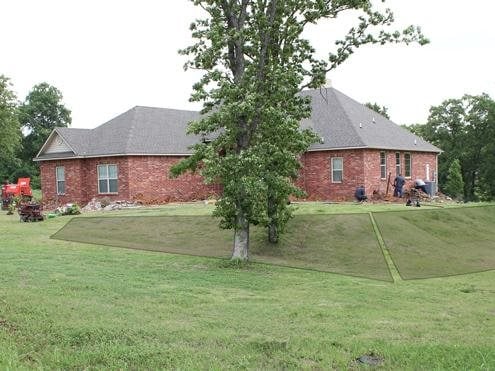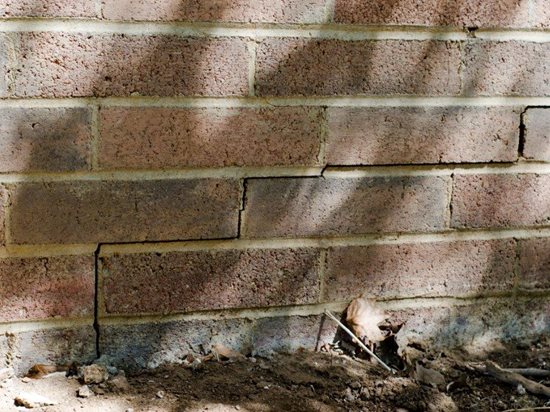- Foundation Repair Home
- Foundation Repair Cost: What are the variables?
- Does Insurance Cover Foundation Repair?
- Foundation Cracks
- Methods of Repair
- Piering: Fixing your home's issues
- Slabjacking: What is slabjacking?
- Related Information:
- Concrete repair: Repair methods and troubleshooting basics
- Read more about foundation information on FoundationRepairNetwork.com
- Houston Foundation Issues: Answers to common questions about foundation problems in Houston
Section Sponsor
Foundation Repair Near Me
Foundation Repair - Fixing Your Home's Foundation Problems
Learn to recognize the signs of foundation problems and how to lift and stabilize sinking concrete.Is the concrete beneath your home in distress? Foundation problems can lead to major structural damage within your home. Whether you’re a homeowner or a perspective buyer, foundation issues are scary and you likely have a lot of questions.
Some of the main questions are:
- Are foundation cracks normal?
- How much will repairs cost?
- Will my insurance cover foundation damage?
Luckily, there are ways to repair a concrete foundation without having to tear it out and start from scratch.
If you suspect trouble, do the following:
- Examine the foundation yourself for obvious issues
- Have a repair expert do a home foundation inspection
- Consult with a structural engineer if necessary
Find a specialist offering foundation repair near me.
WHAT ARE THE SIGNS OF FOUNDATION PROBLEMS?
Are you wondering if you have foundation issues? All foundations will settle with time, but problems arise when this settlement is uneven or extreme.
Here are the common signs of foundation stress:
Exterior Warning Signs
- Wall rotation
- Separation around garage door, windows and/or walls
- Cracked bricks
- Broken and/or cracked foundation
- Displaced moldings
Interior Warning Signs
- Misaligned doors and windows
- Cracked sheetrock
- Cracks in floor
- Uneven floors
See these foundation problem pictures so you know exactly what to look for at your house.
Bulging floors, cracked walls, and doors that won't close are all signs of foundation distress. Sixty percent of all homes built on expansive soils suffer from foundation distress. The trouble occurs when only part of the foundation heaves or settles, causing cracks and other damage.
This differential movement is largely caused by differences in soil moisture. Loss or gain of soil moisture can cause serious shrinkage or swelling.
If the frame of a house does not begin to distort until after three or more years of satisfactory performance, it is doubtful that the distortion is caused by full-depth foundation settlement, which is always evidenced by matching cracks. Cracks occur at each side of a portion of the foundation wall that is undergoing downward movement caused by soil bearing failure.
Settlement cracks are nearly always vertical, and they should not be confused with cracks that occur when a wall is subjected to lateral movement from soil pressure.
WHAT CAUSES FOUNDATION ISSUES?
For the vast majority of damage, water is the primary culprit. Variations in moisture cause components of the soil to swell or shrink, leading to movement beneath your foundation.
Your property may be more susceptible to foundation damage if:
- It was built on expansive clay
- It was built on improperly compacted fill soils
- The area around the foundation has poor drainage
- You live in an area with extreme seasonal changes
- You experienced a plumbing leak below your home
- Tree roots are growing too close to your home
- An earthquake, flood or drought compromised the structure
Those soils highest in clay content are generally more susceptible while those lowest in clay content are the least affected. In some areas the movement is insignificant; in others, it is quite pronounced.
When unstable soils are used as a base, the movement is transferred to the foundation. Since soil movement is rarely uniform, the foundation is subjected to a differential or upheaval. The problem shows up in both slab, and pier and beam type foundations.
If all the soil beneath a foundation swells uniformly, there usually is no problem. Issues occur, however, when only part of the home settles. Then, the differential movement causes cracks or other damages.
Issues resulting from foundation settlement:
- Damage to the structure
- Loss of real estate value
- Tripping hazards
- Unsightly cracks
- Equipment malfunctions
Whatever the cause, settlement can destroy the value of your home and even render it unsafe. If you see signs of failure, don't delay in getting the problem solved. The longer you wait, the more your foundation will sink, causing further costly damage.
FOUNDATION CRACKS
Hairline cracks are a common result of normal foundation settlement. However, you should be concerned if large cracks appear suddenly. If a crack is wider than an eighth of an inch you could have a possible foundation issue.
According to a Realtor.com article about foundation problems:
“Horizontal or jagged 45-degree cracks are the most serious and usually indicate you will need professional help.”
If unsure, monitor the cracks in your foundation, if they continue to expand, call a foundation company out to inspect the cracking.
CONCRETE FOUNDATION REPAIR METHODS
Past techniques for repair of sunken concrete has varied. Wood, concrete, cement and steel have been poured, pushed, turned or somehow forced into the ground trying to salvage these foundations and slabs, while early on, anyone and everyone, trained or untrained, became "experts" at this type of repair. Often as not, the repairs proved to be futile.
Other, more successful, methods of remediation involve extensive disruption of the family or business using the building. Usually, it is desirable that settlement of building slabs and monolithic foundations in residential areas be corrected without having to move all furniture, appliances, and possibly the whole family, or in commercial areas, without disrupting business.
However, with today’s technology and trained experts, there are a number of very successful solutions to the problem of sunken concrete that involve little or no disruption to normal living or business routine.
The two most common methods of this type of repair are slabjacking and hydraulic jacking (also known as piering).
In a slabjacking operation, grout is pumped beneath a slab or beam to produce a lifting force that restores the member to its original elevation.
In piering, steel posts are driven through unstable soil and hydraulic jacks are used to raise or stabilize concrete slabs affected by changes in the underlying soil. The repair method used depends on the type of distress being treated.
Choosing the correct method for repairs
Before deciding on a repair method, you must determine what is causing the distress. Examine moldings and trim boards, mortar joints in brick veneer, and windows in low areas for clues. Also take note of recent weather. Unusually dry or wet weather can cause movement in the underlying soil.
The most commonly used method of correcting smaller slabs of sunken concrete, such as residential slabs, driveways, sidewalks, swimming pool decks, etc. is slabjacking.
Slabjacking is done by pumping a cement grout through small, strategically-located holes in the concrete slab. Once in place, the grout solidifies into a dense concrete mass and provides a competent bearing for the concrete slab.
If a soil-cement-lime grout is used, the lime content of the slurry will impart the benefits of lime stabilization to the base or sub-base. This combined treatment not only restores the slab to proper grade but also stabilizes the sub-soil to prevent re-occurrence of the problem.
For larger problems, especially those found in house and commercial building foundation shifting, hydraulic piers are typically used to lift and stabilize the foundation.
Piering involves the use of strategically placed mechanical jacks to lift the settled beam to grade. The beam must be raised carefully to avoid further or unnecessary damage. Once raised, the beam is held to elevation by a specially designed spread footing and pier.
The footing is set deep enough so that it will be independent of variations in soil moisture. It is also designed to adequately distribute the load without creating unnecessary bulk or mass. The pier is tied into the footing with steel and supports the foundation beam.
WHAT REGIONS ARE MOST AFFECTED BY FOUNDATION FAILURE?
The soil type in certain areas of the country leads to a higher rate of foundation trouble. Areas with high clay content and coastal areas with lots of sand tend to see the most damage. Homes in these regions are at greater risk for foundation damage.
Foundation Issues in Texas
The following areas of Texas have expansive clay soil, which can cause foundation movement:
- Dallas
- Fort Worth
- Houston
- Corpus Christi
- Austin
- San Antonio
The soil conditions in Texas respond to rain and drought like a sponge. This expansion and contraction with changes in moisture puts stress on your foundation.
Foundation problems are also prevalent in areas prone to flooding, as was seen with Hurricane Harvey in 2017. If you live in Houston, you may want to elevate your house above the floodplain. FEMA offers this guide about the house elevation process.
Additional factors that contribute to foundation failure in Texas include poor drainage around homes and the corrosion of cast iron plumbing or failure of cedar piers beneath older homes.
For more information:
An Expert’s Guide to Spotting Home Foundation Issues in Texas
Houston Foundation Issues
Dallas Foundation Issues
Foundation Issues in Oklahoma
Areas of Oklahoma, including Tulsa and Oklahoma City, also have soil with high clay content. In fact the dirt is actually red in many places because there is so much clay.
To make the problem worse, Oklahoma often experiences extreme drought (remember learning about the Dust Bowl?) that dries out the soil, making it contract and pull away from foundations.
In Oklahoma, soil expansion and contraction often leads to issues in your home’s basement. Sometimes basement walls will require straightening to properly support your home.
Foundation experts in Oklahoma recommend watering your foundation during times of drought and redirecting rain way away from your home with gutters and proper sloping during times of rain.
Foundation Issues in Missouri
Missouri is another state with more foundation problems than average. Kansas City and St. Louis both have expansive clay soils and variable weather that contribute to the issues.
If your basement is leaky or damp you may need basement waterproofing. Or worse, you may have bowed basement walls that need to be fixed.
Foundation Issues in Mississippi
Mississippi, and Jackson in particular, also have frequent foundation issues. The soil in this area, known as Yazoo clay, weakens foundations, putting them at risk of failure.
The volume of this soil expands when wet and shrinks when dry, sometimes by as much as 38%. This drastic soil movement leads to shifting of structures, breaking of underground plumbing and other damage.
If you have Yazoo clay beneath your home, the key is to keep the moisture consistent. Sometimes this may mean redirecting rainwater away from your house, other times it may mean using a soaker house to prevent the ground from drying out.
IS CLAY THE ONLY TYPE OF SOIL THAT CAUSES FOUNDATION TROUBLE?
Clay isn’t the only type of soil that negatively impacts foundations. The second biggest enemy to concrete house foundations is sand. While sand does not expand and contract like clay soils, it can be washed away, creating gaps beneath a foundation. Peat is another type of soil that shrinks and expands much like clay.
Learn more about expansive soils.
Loam and rock are the best soils for providing foundation support. They compact well and don’t move or swell with moisture changes.
SHOULD I BUY A HOUSE WITH FOUNDATION ISSUES?
Many home buyers run for the hills when they see a home with foundation issues. The fear is that it will cost thousands of dollars to repair the home by raising and sufficiently supporting its foundation.
If you’re shopping for a home, keep an eye out for the common signs of foundation issues. Also, make sure to have a home inspection. However, sometimes foundation trouble is overlooked during this step.
To be sure that the home you wish to purchase is structurally sound, have it evaluated by a foundation contractor or an engineer. They will also be able to give you an idea of how much the repair work will cost, so that you can make an offer with that in mind.
In some cases, you may be able to get a good deal on a home with foundation issues. But make sure you know what you are getting into. Some foundation problems can be corrected easily and affordably, while others may require a completely new foundation and up to $100,000. Don’t go with what a real estate agent says, only a foundation expert can help you determine what to expect.
SHOULD I FIX MY FOUNDATION BEFORE SELLING MY HOME?
If you want to get top dollar for your home, it should be in near perfect condition. This includes fixing foundation issues if you can afford it. See average foundation repair costs.
Most foundation companies offer a lifetime warranty on their repairs that is transferable to the new owners. This will give potential buyers peace of mind because they know that the problem has been addressed.
In some cases you may be able to sell your home as is. It isn’t uncommon for homes with foundation trouble to be bought by investors. Also, if you have the advantage of a seller’s market, some buyers are willing to take on repairs themselves.
For more about this read How to Sell a Home with Foundation Problems.
Related: Concrete Work to Do Before Selling Your Home
HOW TO HIRE A REPAIR CONTRACTOR
Foundation work is definitely not a do-it-yourself project, so it makes good sense to get at least three licensed contractors to give you a detailed proposal along with an assessment of your issues. The average inspection takes about two hours. Ron Davidson of Ram Jack Systems also offers the following advice and precautionary measures:
-
Educate yourself on repair methods and ask a lot of questions. Don't make your final decision based on advertising and cheap prices. If it sounds too good to be true, it probably is.
-
Don't do business with a contractor that does not have their repair methods evaluated by ICC-ES (International Code Council Evaluation Services). This nonprofit organization ensures that building products meet code compliance.
-
In most areas of the country, a reputable contractor will have a clause for the depth of the hydraulic piling (typically 20 to 30 feet). Beyond that depth, there is usually an additional charge, ranging from $20 to $30 per foot. If a contractor has no depth clause, be cautious. It's unlikely that the contractor would continue to operate at a loss, and would instead just stop at the depth that would guarantee a profit.
-
Some repair projects require removal of landscaping in the areas of the work, and the contractor typically won't guarantee that a bush or shrub will survive after removal and replacement.
-
Warranties or guarantees for foundation work are very important, so pay close attention to their terms. Remember that a warranty is only as good as the company that backs it. Look for a national company that can offer a warranty trust. This means that if the company goes out of business, there is a plan in place to provide follow-up service, if needed.







